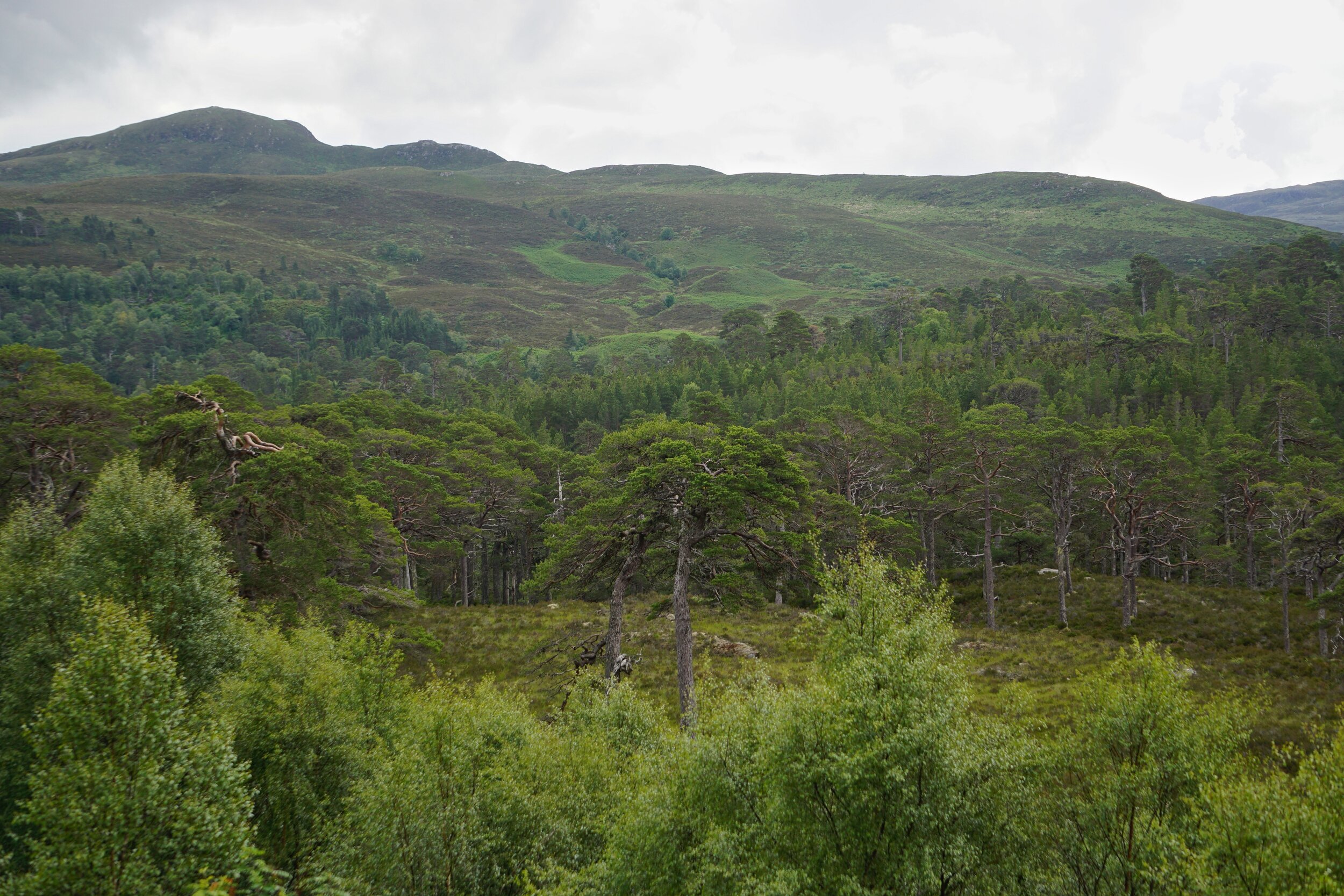The Caledonian Forest, so named because the Romans referred to what is now Scotland as Caledonia, reached its zenith at about 5,000 BC and once covered an estimated 15,000 square kilometers. Such forest once covered much of the island of Great Britain until a warming climate saw these temperate coniferous rainforests dominated by the Scots pine retreating north into Scotland, its last vestige of a suitable climatic environment. The Scots pine were joined by other species like birch, rowan, aspen, juniper, oak and more and the land was rich in ground cover of ferns, mosses and lichens. This warming climate change reduced the forest significantly and by 2,000 BC and onwards, human actions, including the grazing of sheep and deer, has continued its decline until today merely 1% of this great forest survives.
Glen Affric is listed in the Caledonian Pinewood Inventory and contains the third largest area of ancient Caledonian pinewoods in Scotland. Because of the importance of this woodland it has been classified as a national nature reserve since 2002
What woodland area has survived is today limited to small, fragmented pockets dotted across the highland landscape, often only in areas that are too steep, rocky, or remote to be suitable for agriculture. Along with the loss of these woodlands thru the ages has been the loss of significant wildlife, including some of the UK’s rarest species. Extinct from these pine forests are the brown bear, the lynx, the grey wolf and others, with the Scottish wildcat, the red squirrel and still more more severely threatened. Breeding bird species like the Capercaillie, the Scottish crossbill and others are found nowhere else in the British Isles and thus their future depends on these pine forests. From 15,000 square kilometers to now barely 180 square kilometers, the Caledonian forest today can barely cast a shadow across its once vast expanse.
The Scottish Highlands landscape today consists largely of vast treeless expanses and rugged barren mountains . Click on any image to enlarge.
At its zenith, much of the Scottish Highlands landscape would have been sheathed in pinewood forests like this one.
Trees for Life is a charity working to rewild the Scottish highlands. This begins with the planting of trees but expands to include the revitalization of the woodland ecosystem and habitat from the ground up – from soil conservation to ground covering to insects, birds, mammals, and yes, the trees that tower above it all.
Founded in 1993, Trees for Life has worked tirelessly with a vision to restore the Caledonian Forest. In 2008 the charity purchased Dundreggan, a highland estate that today serves as a tree nursery where they have successfully grown not just the iconic Scots pine, but rare trees such as Aspen, willows, and birches. The charity is also involved in programs to expand the footprint of red squirrels across Scotland, and to reintroduce species like the beaver to highland rivers and lochs.
A restored Caledonian Forest would include not just Scots pine but many other species including birch and aspen and would be home to species like the Capercaillie, the Scottish wildcat, and the red squirrel. Click on any image to enlarge.
I first learned of the work of Trees for Life from my dear friend, Scottish Travel blogger Susanne Arbuckle of Adventures Around Scotland. Susanne’s love of her homeland led her to support Trees for Life by creating a small grove of trees to which her followers, including myself, can contribute. Having done this I wanted to know more about the charity’s work so I sought out Doug Gilbert, Conservation Manager at Dundreggan to learn more about the once majestic Caledonian Forest, what’s being done to revitalize these woodlands, and not just how, but why we all should be concerned and do what we can to support their efforts.
KEY POINTS:
•06:15 What was the Caledonian Forest like in its prime?
•12:15 A major threat to the remaining forest’s own rejuvenation is overgrazing by sheep and deer.
•14:30 Trees for Life are involved in land management with private estates, land owners, and other partners.
•21:45 TFL are working to restore existing woodland pockets while also planting in open areas to bridge existing fragments together.
•26:30 How can restoring the forest aid the battle against climate change?
*29:30 How can the public get involved in supporting Trees for Life?
•33:00 Where in Scotland can tourist/visitors go to see examples of the once vast Caledonian Forest and the work done by Trees for Life?
•35:45 Why is there a need for Trees for Life? Why not let nature takes its course?
•37:00 How different will Scotland be in 50, 100, 300 years if the forest is successfully restored?
Fore More Information:
• Trees for Life (website)
• The History and Mystery of the Scots Pine (Scottish Forestry Trust)
• What was the Caledonian Forest? (World Atlas)
• Adventures Around Scotland (Travel blog website)















